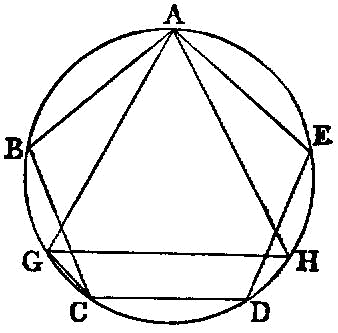Proposition 4.16

In a given circle to inscribe a fifteen-angled figure which shall be both equilateral and equiangular.
Let ABCD be the given circle; thus it is required to inscribe in the circle ABCD a fifteenangled figure which shall be both equilateral and equiangular.
In the circle ABCD let there be inscribed a side AC of the equilateral triangle inscribed in it, and a side AB of an equilateral pentagon; therefore, of the equal segments of which there are fifteen in the circle ABCD, there will be five in the circumference ABC which is one-third of the circle, and there will be three in the circumference AB which is one-fifth of the circle; therefore in the remainder BC there will be two of the equal segments.
Let BC be bisected at E; [III. 30] therefore each of the circumferences BE, EC is a fifteenth of the circle ABCD.
If therefore we join BE, EC and fit into the circle ABCD straight lines equal to them and in contiguity, a fifteen-angled figure which is both equilateral and equiangular will have been inscribed in it. Q. E. F.
And, in like manner as in the case of the pentagon, if through the points of divsion on the circle we draw tangents to the circle, there will be circumscribed about the circle a fifteen-angled figure which is equilateral and equiangular.
And further, by proofs similar to those in the case of the pentagon, we can both inscribe a circle in the given fifteenangled figure and circumscribe one about it. Q. E. F.
